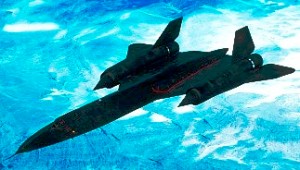
Created by Kelly Johnson, the Lockheed SR-71 also known as the "Blackbird" or "Habu", was developed as a black project from the Lockheed A-12 reconnaissance aircraft in the 1960's by Lockheed and its Skunk Works. It was an advanced, long-range, Mach 3+ strategic reconnaissance aircraft which was designed as a high-speed high altitude aircraft, providing pre-attack and post-attack reconnaissance. During reconnaissance missions the SR-71 operated at high speeds and altitudes to allow it to out race threats. If a surface-to-air missile launch was detected, the standard evasive action was simply to accelerate and out-fly the missile.
SPECIFICATIONS: 
Armament: None
Engines: Two Pratt & Whitney J58s of 32,500 lbs. thrust each with afterburner
Maximum speed: Plus 2,000 mph
Range: Plus 2,900 miles
Service ceiling: Plus 85,000 ft.
Span: 55 ft. 7 in.
Length: 107 ft. 5 in.
Height: 18 ft. 6 in.
Weight: 170,000 lbs. loaded
Crew: Two
Serial number: SR-71A: 61-7950 to 61-7955, 61-7958 to 61-7980 | SR-71B: 61-7956 and 61-7957 | SR-71C: 61-7981

Armament: None
Engines: Two Pratt & Whitney J58s of 32,500 lbs. thrust each with afterburner
Maximum speed: Plus 2,000 mph
Range: Plus 2,900 miles
Service ceiling: Plus 85,000 ft.
Span: 55 ft. 7 in.
Length: 107 ft. 5 in.
Height: 18 ft. 6 in.
Weight: 170,000 lbs. loaded
Crew: Two
Serial number: SR-71A: 61-7950 to 61-7955, 61-7958 to 61-7980 | SR-71B: 61-7956 and 61-7957 | SR-71C: 61-7981
Constructed of 93% titanium alloy and composites, it produces original stealth technology. The application of a special paint giving it a higher thermal emissivity when cruising at high Mach. The paint also contains tiny iron balls that dissipates electromagnetic radiation. The paint alone adds over 60 lbs to the jet. In order to match the strength of the aircraft's titanium structure; special fuels, hydraulic fluids, electronics, and glass had to be developed. The Blackbird was both a miracle of design and of production. The reasons behind this is due to its performance had to overcome not only the sound barrier, but also the heat barrier. The skin temperature of the craft exceeded 1,050 °F.
The USAF tried retiring the Blackbird in 1987, since the SR-71 fleet was so expensive to maintain. The SR-71 program was completely shut down with its first official retirement in 1989. The requirement of expedited reconnaissance became clear during the 1993 conflict in Middle East which lead to the re-examination of SR-71 program by congress. The renewal of the Blackbird fleet was the result from the congress. Due to this, the Blackbird project was finally (and permanently) retired in 1998. Two last flying Blackbirds were given to NASA which flew until 1999. All but two SR-71’s (the ones given to NASA) are now in museums for people to see.
No comments:
Post a Comment